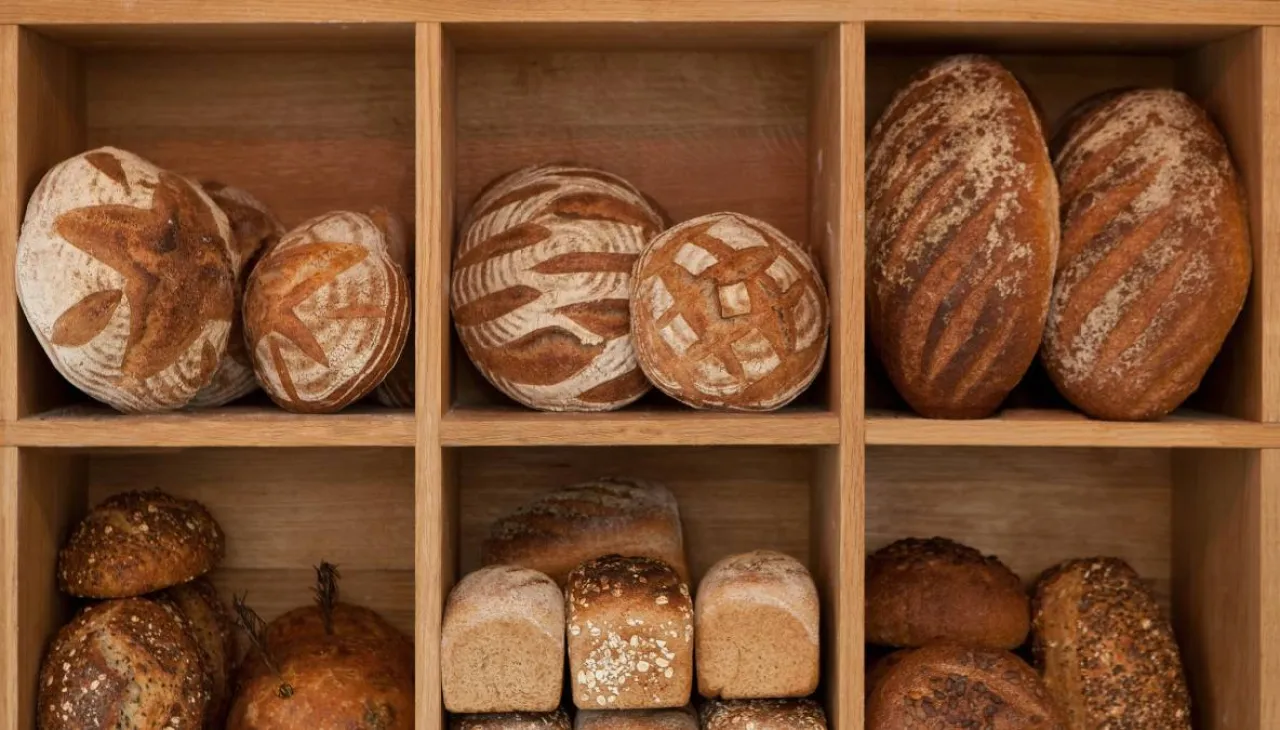Healthy breads, including whole grain, ancient grains, and gluten-free options, can significantly enhance your diet by providing essential nutrients and supporting overall wellness. However, many people struggle to incorporate these nutritious choices into their meals effectively. This article offers practical strategies and innovative ideas for integrating healthy breads into your daily routine, ensuring you can enjoy their benefits without sacrificing flavor or variety.
From creating gourmet sandwiches to incorporating breads into breakfasts, salads, and even desserts, these suggestions will help you make the most of healthy bread options. Explore these creative methods to elevate your meals while boosting your nutritional intake.
In this article you will find:
Nutritional Benefits of Whole Grain Breads
Whole grain breads are more than just a delicious addition to your meals; they are packed with numerous nutritional benefits that can significantly enhance your overall health. Unlike refined breads, which often strip away essential nutrients, whole grain breads retain the bran, germ, and endosperm, offering a more wholesome option. Here’s a closer look at what makes whole grain breads a vital part of a healthy diet.
Rich in Nutrients
Whole grain breads are nutrient-dense, providing a wealth of vitamins and minerals. Key nutrients found in whole grains include:
- Fiber: Whole grain breads are an excellent source of dietary fiber, which aids in digestion, helps maintain a healthy weight, and reduces the risk of chronic diseases.
- B Vitamins: Whole grains are rich in B vitamins, such as thiamine, riboflavin, niacin, and folate, which play crucial roles in energy metabolism and overall health.
- Minerals: These breads also provide essential minerals like iron, magnesium, and selenium, which are important for various bodily functions, including immune response and bone health.
Heart Health Benefits
Incorporating whole grain breads into your diet can have a positive impact on heart health. Studies have shown that consuming whole grains can lower cholesterol levels and reduce the risk of heart disease. The fiber in whole grains helps to lower LDL (bad) cholesterol and improve overall cardiovascular health.
Weight Management
Whole grain breads can be a valuable ally in your weight management journey. The high fiber content promotes satiety, meaning you feel fuller for longer, which can help control hunger and reduce overall calorie intake. Additionally, the complex carbohydrates in whole grain breads provide a steady source of energy, preventing the spikes and crashes associated with refined carbohydrates.
Lower Risk of Chronic Diseases
Regular consumption of whole grain breads is linked to a lower risk of several chronic diseases, including:
- Type 2 Diabetes: Whole grains can improve insulin sensitivity and help regulate blood sugar levels.
- Certain Cancers: A diet high in whole grains may be associated with a reduced risk of colorectal and other cancers.
- Digestive Disorders: The fiber in whole grains supports healthy digestion and may help prevent conditions such as diverticulitis.
Choosing the Right Whole Grain Bread
When shopping for whole grain bread, it’s essential to read labels carefully. Look for products that list whole grains as the first ingredient and contain minimal added sugars and preservatives. Some popular options include:
- 100% whole wheat bread
- Rye bread
- Oat bread
- Spelt bread
By choosing whole grain breads, you can enjoy not only the delightful flavors and textures but also the multitude of health benefits they offer. For more information on the nutritional advantages of whole grains, you can explore resources from the Whole Grains Council.
Exploring Ancient Grains for Modern Health
Ancient grains are gaining popularity in today’s health-conscious world, offering a nutritious alternative to conventional grains. These grains, which have been cultivated for thousands of years, are not only rich in flavor but also packed with essential nutrients that can contribute to overall wellness. Let’s delve into some of the most beneficial ancient grains and how they can enhance your diet.
What Are Ancient Grains?
Ancient grains refer to the grains that have remained largely unchanged over the years, preserving their original structure and nutritional profile. Unlike modern grains that have been heavily refined and processed, ancient grains provide a wealth of health benefits. Some well-known ancient grains include:
- Quinoa: Often referred to as a superfood, quinoa is a complete protein, containing all nine essential amino acids, making it an excellent choice for vegetarians and vegans.
- Farro: This nutty grain is high in fiber, protein, and a variety of minerals, contributing to heart health and digestive wellness.
- Spelt: Spelt is an ancient form of wheat that is easier to digest than modern wheat and is rich in vitamins and minerals.
- Teff: A staple in Ethiopian cuisine, teff is high in calcium and iron and is the key ingredient in injera, a traditional sourdough flatbread.
Nutritional Advantages of Ancient Grains
Incorporating ancient grains into your diet can provide numerous health benefits:
- Higher Nutrient Density: Ancient grains typically contain more nutrients compared to their modern counterparts, including higher levels of fiber, protein, vitamins, and minerals.
- Support Digestive Health: The fiber content in ancient grains helps maintain a healthy digestive system by promoting regularity and preventing constipation.
- Lower Glycemic Index: Many ancient grains have a lower glycemic index than refined grains, making them a better option for maintaining stable blood sugar levels.
- Rich in Antioxidants: Ancient grains are often rich in antioxidants, which can help combat oxidative stress and reduce the risk of chronic diseases.
Integrating Ancient Grains into Your Diet
Adding ancient grains to your meals is easier than you might think. Here are some simple and delicious ways to incorporate them into your diet:
- Breakfast Bowls: Use cooked quinoa or farro as a base for breakfast bowls, topped with fruits, nuts, and a drizzle of honey.
- Salads: Add cooked ancient grains to salads for a hearty and nutritious boost. They pair well with fresh vegetables, proteins, and dressings.
- Soups and Stews: Incorporate ancient grains into soups and stews to enhance texture and nutrition. They absorb flavors beautifully and add a satisfying chew.
- Baking: Experiment with ancient grain flours, such as spelt or teff, in your baking recipes for a unique flavor profile and added nutrition.
The Future of Ancient Grains
As more people become aware of the health benefits associated with ancient grains, their popularity continues to grow. They not only offer a nutritious alternative but also support sustainable agricultural practices. Many ancient grains require less water and are more resilient to environmental changes, making them a smart choice for a sustainable diet.
For more information on ancient grains and their health benefits, check out the Whole Grains Council, which offers a wealth of resources and recipes to inspire your culinary adventures.
Gluten-Free Options That Don’t Sacrifice Flavor
For those with gluten sensitivities or celiac disease, finding delicious and satisfying bread options can often feel like a challenge. However, the good news is that the gluten-free market has evolved significantly, offering a variety of flavorful alternatives that cater to diverse tastes and dietary needs. Let’s explore some of the best gluten-free bread options that ensure you never have to compromise on flavor.
Understanding Gluten-Free Grains
Gluten-free breads are typically made from a variety of alternative grains and flours. These include:
- Almond Flour: Rich in protein and healthy fats, almond flour creates a moist and flavorful bread that is perfect for those seeking a low-carb option.
- Coconut Flour: This flour is high in fiber and absorbs a lot of moisture, making it an excellent choice for dense, sweet breads.
- Rice Flour: A staple in gluten-free baking, rice flour provides a light texture and is often blended with other flours to enhance flavor.
- Chickpea Flour: Packed with protein, chickpea flour lends a nutty flavor and is ideal for savory breads.
Top Gluten-Free Bread Brands
Many brands have stepped up their game in the gluten-free market, creating products that are both delicious and nutritious. Here are some notable brands to consider:
- Udi’s Gluten Free: Known for their soft and flavorful loaves, Udi’s offers a variety of options, including whole grain and classic sandwich bread.
- Schär: This brand is dedicated to gluten-free products and offers a range of breads, including ciabatta and baguettes, that mimic traditional flavors and textures.
- Dave’s Killer Bread: Their gluten-free line includes hearty options made with whole grains and seeds, delivering both flavor and nutrition.
- Rudi’s Organic Bakery: Rudi’s offers gluten-free breads that are organic and made without artificial preservatives, ensuring a clean label.
Homemade Gluten-Free Bread Recipes
Making your own gluten-free bread at home can be a rewarding experience that allows you to customize flavors and ingredients. Here are two simple recipes to try:
Almond Flour Bread
- 2 cups almond flour
- 1/4 cup coconut flour
- 1/2 tsp baking soda
- 1/4 tsp salt
- 5 eggs
- 1/4 cup melted coconut oil
- 1 tbsp honey (optional)
Mix all ingredients until well combined. Pour into a greased loaf pan and bake at 350°F (175°C) for 30-35 minutes or until golden brown. Allow to cool before slicing.
Chickpea Flour Flatbread
- 1 cup chickpea flour
- 1 cup water
- 1/2 tsp salt
- 1 tbsp olive oil
Whisk together the ingredients until smooth. Heat a non-stick skillet over medium heat, pour in the batter, and cook for about 3-4 minutes on each side or until golden. Serve warm with your favorite toppings.
Flavor Enhancements for Gluten-Free Bread
To elevate the flavor of gluten-free breads, consider adding ingredients such as:
- Herbs and Spices: Incorporate fresh or dried herbs like rosemary, thyme, or garlic powder for an aromatic twist.
- Seeds and Nuts: Adding sunflower seeds, chia seeds, or chopped nuts can enhance texture and nutritional value.
- Sweeteners: For sweet breads, experiment with natural sweeteners like maple syrup or agave nectar for a unique taste.
As the gluten-free movement continues to grow, there are more resources and products available than ever. For additional recipes and tips on gluten-free cooking, visit the Celiac Disease Foundation, which provides comprehensive information on gluten-free living.
Innovative Ways to Incorporate Healthy Breads into Your Diet
Healthy breads, whether they are whole grain, ancient grains, or gluten-free options, can be versatile additions to your meals. By thinking outside the box, you can elevate your dining experience while reaping the nutritional benefits of these breads. Here are some creative ways to incorporate healthy breads into your diet without sacrificing flavor or variety.
1. Bread as a Base for Creative Sandwiches
Sandwiches don’t have to be boring. Use healthy breads as a base to craft gourmet sandwiches that excite your taste buds. Consider these ideas:
- Avocado Toast: Spread ripe avocado on whole grain or gluten-free bread, then top with cherry tomatoes, radishes, or a poached egg for a nutritious breakfast or snack.
- Open-Faced Sandwiches: Layer protein-rich ingredients such as smoked salmon, hummus, or turkey on a slice of dense bread like rye or spelt. Add fresh veggies and a drizzle of dressing for added flavor.
- Grilled Cheese Reinvented: Use whole grain or gluten-free bread with your favorite cheese and add spinach, tomato, or even a slice of apple for a sweet twist.
2. Creative Bread-Based Breakfasts
Breads can be the star of your breakfast. Here are some innovative breakfast ideas that incorporate healthy breads:
- French Toast with a Twist: Use whole grain or gluten-free bread to make French toast. Dip the slices in a mixture of eggs, almond milk, and cinnamon, then cook until golden. Top with fresh fruits and a drizzle of maple syrup.
- Breakfast Bruschetta: Toast slices of healthy bread and top them with ricotta cheese, honey, and sliced figs or peaches for a delicious and nutritious morning treat.
- Nut Butter & Banana Toast: Spread almond or peanut butter on a slice of whole grain bread and top with banana slices and a sprinkle of chia seeds for added crunch and nutrition.
3. Using Bread in Salads and Soups
Incorporate healthy breads into salads and soups for added texture and flavor:
- Croutons: Cube and toast healthy bread to create homemade croutons. Toss them into salads or soups to add a satisfying crunch. Season with your favorite herbs and spices for extra flavor.
- Panzanella Salad: This Italian bread salad is a great way to use up stale bread. Combine cubes of whole grain or sourdough bread with ripe tomatoes, cucumbers, onions, and a vinaigrette for a refreshing dish.
- Thickening Soups: Blend pieces of healthy bread into pureed soups for added creaminess and nutrition. Whole grain or rustic bread works beautifully in creamy tomato or vegetable soups.
4. Bread as a Healthy Snack
Transform healthy breads into satisfying snacks throughout the day:
- Mini Pizzas: Use pita or whole grain bread as a base for mini pizzas. Top with tomato sauce, cheese, and your choice of vegetables and bake until bubbly.
- Stuffed Bread Rolls: Fill whole grain rolls with ingredients like turkey, spinach, and cheese. Wrap them in foil and heat in the oven for a quick snack.
- Sweet Bread Bites: Cut healthy bread into bite-sized pieces, toast them, and serve with a side of yogurt or fruit dip for a delightful snack.
5. Bread as a Dessert Component
Healthy breads can even be used in desserts, making them a versatile ingredient:
- Bread Pudding: Use whole grain bread to make a delicious bread pudding. Combine cubed bread with a mixture of eggs, milk, and spices, then bake until set.
- Fruit and Bread Parfaits: Layer pieces of healthy bread with yogurt and fresh fruits for a tasty and nutritious dessert.
- Chocolate Hazelnut Bread Sandwiches: Spread chocolate hazelnut spread between two slices of whole grain or gluten-free bread for a decadent treat.
Incorporating healthy breads into your diet can open up a world of culinary possibilities. For more tips and recipes on how to creatively use healthy ingredients in your meals, check out EatingWell, which offers a variety of nutritious recipes and cooking advice. Incorporating healthy breads, such as whole grain, ancient grains, and gluten-free options, into your diet offers numerous nutritional benefits, including improved heart health, weight management, and a reduced risk of chronic diseases. These breads are rich in fiber, vitamins, and minerals, making them a wholesome addition to meals.
To enjoy these benefits, consider using healthy breads creatively in your meals. Transform them into gourmet sandwiches, innovative breakfasts like French toast, or add them to salads and soups for texture. You can also use them as a base for healthy snacks and desserts, enhancing your culinary experience while maintaining nutritional value. For more ideas and recipes, explore resources like the Whole Grains Council and EatingWell.




